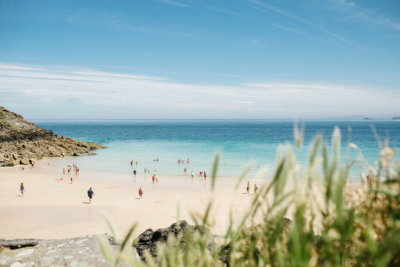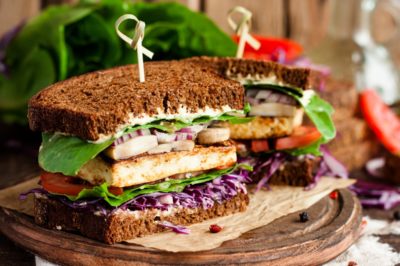What is duck farming and how are ducks treated? Find out in our blog

In the UK, ducks are reared for their meat, eggs, feathers and down, and some are also reared just to be shot.
In other countries, ducks are also farmed specifically for their livers which are made into foie gras.
Almost all ducks are reared under factory farm conditions and are selectively bred. Some also endure painful beak trimming.
Crucially, many are denied access to open water, which is a fundamental need for water birds, and without which they can suffer eye problems. Some even go blind.
Ducks need water to control their body temperature and can suffer from heat stroke in crowded conditions. Lack of access to water can cause anxiety and stress-related behaviours such as head shaking and obsessive feather preening.
Ducks Reared for Meat
Ducks are kept in the same kinds of factory farm sheds as chickens and turkeys. Almost all are crammed into units with thousands of other birds where the feed and lighting is manipulated to maximise weight gain.
Around 18 million birds are reared for their meat each year[1] and just two per cent are free-range.[2]
Lameness affects ducks and is associated with rapid growth and weight gain. Researchers have reported high incidences of ‘splay leg’ or ‘spaddle leg’ in farmed ducks: a condition where the ducks’ legs splay outwards, leaving the birds unable to stand.
In the filthy and overcrowded sheds, diseases can spread rapidly. Psittacosis, for example, can cause trembling, conjunctivitis and diarrhoea, with up to one-third of affected birds dying. [3]
Aspergillosis is a fatal condition associated with stressful and unhygienic living conditions, and avian influenza, originally a harmless infection of aquatic birds, has mutated and spread under farm conditions, and now threatens both birds and people.
Between February 2013 and May 2017, there were 579 human deaths from one strain of avian flu. [4]

Ducks Reared for Eggs
Most birds used for eggs are kept indoors under intensive conditions, with producers keeping tens of thousands of birds who lay millions of eggs per year. [5]
Like factory-farmed hens, they are sent to slaughter when productivity declines.
Where do Feathers and Down Come from?
Duck feathers and down (the soft fluffy under-feathers) are taken to insulate and pad items such as pillows, sleeping bags and jackets.
They are highly profitable and are ‘harvested’ from birds in different ways. Most commonly, they are taken during the slaughter process but they may also be gathered during the birds’ natural moulting cycle or live-plucked.
During this process, birds are restrained and have their feathers pulled out of them. It is a painful procedure, and incorrect handling also can cause injuries to necks, legs and wings.
Foie gras
Foie gras (French for ’fatty liver’) is produced by force-feeding the birds. Up to three times a day, a tube is pushed down their throats and food is forced into their stomachs.
This causes their livers to swell up to ten times their natural size. [6] The process is so cruel it is banned in the UK, Germany, Italy, Argentina, Australia and several other countries [7] but it remains legal to import the finished product.

Since only the males who gain weight quickly are used for foie gras production, the females are considered a ‘by-product’ and are usually killed within a day or two of hatching.
For the males, force-feeding is violent and traumatic, with rough handling often causing injury or death. Most ducks bred for foie gras are kept in cages.
This Animal Equality film shows how ducks are reared for foie gras.
A survey carried out in 2012 found that 63 per cent of British people would like to see the sale of foie gras banned in the UK, and several councils have banned it on council properties.
Thanks to campaign group Viva!, no major supermarket chain currently sells foie gras in the UK.
The Shooting Industry
Around 1.4 million ducks are bred, reared and released by the shooting industry.[8]
A 2009 investigation by Animal Aid shone a light on the conditions the birds endure before being turned out, just so they can be shot down for ‘sport’.
Transportation and slaughter
Ducks are typically caught by their necks and loaded into crates for transportation. During this process, birds may become bruised or suffer injuries to their heads and wings. Some may suffer dislocated hips and haemorrhages.
At the slaughterhouse, the birds are hung upside down by their legs, dragged through electrified water to stun them (it is not always effective), and have their throats cut.
Viva! documented duck slaughter in its 2010 investigation.
Ducks love life!
Ducks are outgoing, inquisitive and sociable animals, living in large flocks and migrating in family groups.
They spend much of their days searching for food, and they sleep within family groups at night. They are very clean creatures, keeping themselves and their nests in pristine condition.
According to UK scientists, ducks also have regional accents. City ducks have a ‘shouting’ quack to compensate for living in a noisy environment, whereas country ducks have a much subtler-toned ‘quack’.[9]
Rescued ducks have been found to quack along to the sound of a telephone, and love to be in the company of people and other animals.
Most of all, they love to be around water, and will even splash around in a washing-up bowl given the chance!

Photo credit: [email protected] via Visual hunt / CC BY-NC
References
[1] John Newton, ‘An overview of the UK Duck Industry’, ADAS, Nov 2012
[2] Ibid
[3] Ibid
[4] ‘Avian Flu Fast Facts’, CNN, 26 May 2017
[6] ‘Foie Gras Production’, Compassion in World Farming, September 2010
[7] ‘Foie gras: why is this French delicacy so controversial?’, The Telegraph, 12 Feb 2016
[8] ADAS, 2012
[9] ‘Ducks “quack in regional accents”’, BBC News, 4 June 2004











